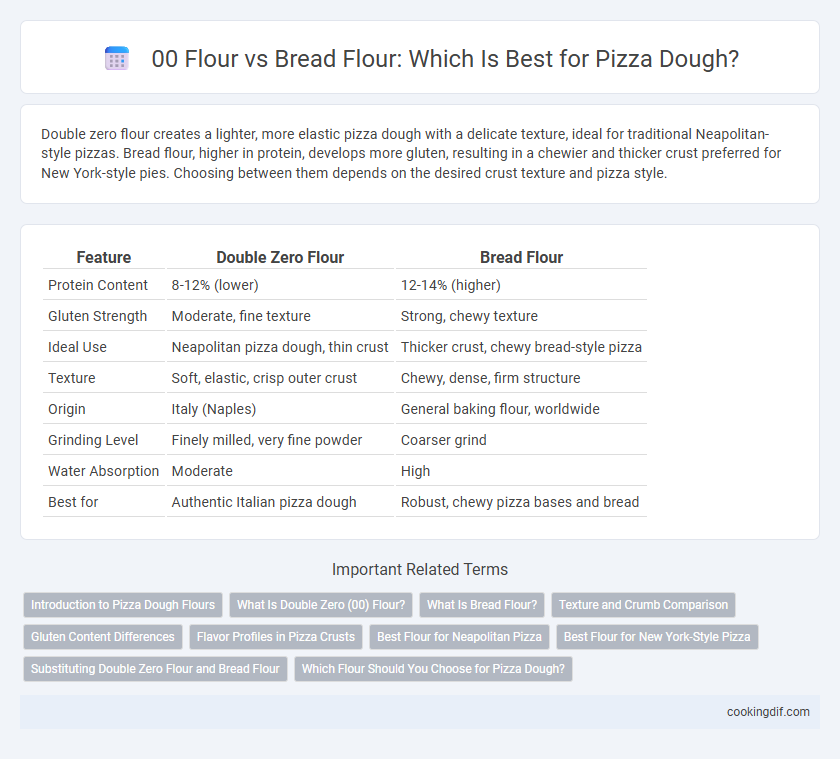Double zero flour creates a lighter, more elastic pizza dough with a delicate texture, ideal for traditional Neapolitan-style pizzas. Bread flour, higher in protein, develops more gluten, resulting in a chewier and thicker crust preferred for New York-style pies. Choosing between them depends on the desired crust texture and pizza style.
Table of Comparison
| Feature | Double Zero Flour | Bread Flour |
|---|---|---|
| Protein Content | 8-12% (lower) | 12-14% (higher) |
| Gluten Strength | Moderate, fine texture | Strong, chewy texture |
| Ideal Use | Neapolitan pizza dough, thin crust | Thicker crust, chewy bread-style pizza |
| Texture | Soft, elastic, crisp outer crust | Chewy, dense, firm structure |
| Origin | Italy (Naples) | General baking flour, worldwide |
| Grinding Level | Finely milled, very fine powder | Coarser grind |
| Water Absorption | Moderate | High |
| Best for | Authentic Italian pizza dough | Robust, chewy pizza bases and bread |
Introduction to Pizza Dough Flours
Double zero flour offers a finely milled texture with a high protein content, ideal for creating soft, elastic pizza dough that achieves the signature thin and crispy crust of Neapolitan-style pizzas. Bread flour contains a higher gluten level than all-purpose flour, providing strength and chewiness, making it a popular choice for thicker, more robust pizza crusts. Choosing between double zero and bread flour depends on the desired dough texture and style, with double zero excelling in delicate chew and bread flour supporting a heartier bite.
What Is Double Zero (00) Flour?
Double zero (00) flour is a finely milled Italian wheat flour known for its ultra-soft texture and low protein content, typically around 8-9%, ideal for creating tender, elastic pizza dough with a light, airy crust. Unlike bread flour, which contains higher protein levels (around 12-14%) for stronger gluten development and a chewier texture, 00 flour allows for better water absorption and faster gluten formation, making it perfect for thin-crust Neapolitan-style pizzas. Its unique grind and quality contribute to a dough that stretches easily without tearing, producing the signature soft yet crisp bite characteristic of traditional Italian pizzas.
What Is Bread Flour?
Bread flour is a high-protein wheat flour containing 12-14% gluten, which provides strong elasticity and chewiness to pizza dough. This flour type is ideal for creating dough with a sturdy structure, perfect for thick-crust or pan-style pizzas. Its high gluten content helps trap carbon dioxide during fermentation, resulting in a dough that rises well and develops a hearty texture.
Texture and Crumb Comparison
Double zero flour produces a pizza dough with a soft, tender crumb and a delicate, thin crust, prized for its finely milled texture and lower protein content. Bread flour, with its higher protein levels, yields a chewier, more elastic dough featuring a thicker, airier crumb with pronounced chewiness and structure. Understanding the protein differences between double zero (around 8-10%) and bread flour (typically 12-14%) is crucial for achieving the desired pizza texture and crumb.
Gluten Content Differences
Double zero flour contains a lower gluten content, typically around 8-12%, resulting in a softer, more elastic dough ideal for traditional Neapolitan-style pizza crusts. Bread flour has a higher gluten content, usually 12-14%, which produces a chewier and more structured dough better suited for thick or pan-style pizzas. The gluten content difference directly affects dough elasticity, rise, and texture, influencing the final pizza crust's bite and chewiness.
Flavor Profiles in Pizza Crusts
Double zero flour creates a tender, delicate pizza crust with a mild, slightly nutty flavor due to its finely milled texture and lower gluten content. Bread flour produces a chewier, more robust crust with a complex, toasted wheat flavor from its higher protein and gluten levels. Choosing between double zero and bread flour directly impacts the crust's texture and flavor profile, tailoring the pizza experience from light and airy to hearty and satisfying.
Best Flour for Neapolitan Pizza
Double zero flour, or "00" flour, is traditionally preferred for Neapolitan pizza due to its finely milled texture and lower protein content, typically around 11-12%, which yields a tender, soft crust with an airy crumb. Bread flour, with higher protein content (12-14%), produces a chewier, denser crust but may compromise the delicate balance essential in authentic Neapolitan pizza. Using 00 flour ensures optimal gluten development and elasticity tailored to the high-temperature, short baking time characteristic of true Neapolitan pizza.
Best Flour for New York-Style Pizza
Double zero flour, prized for its ultra-fine grind and high protein content, creates a smooth, elastic dough ideal for the thin, chewy crust characteristic of New York-style pizza. Bread flour, with a slightly higher protein percentage, contributes to stronger gluten development, yielding a crispier and chewier texture perfectly suited for the iconic foldable slices. Both flours excel, but double zero flour offers better extensibility, while bread flour enhances crust structure, making choice a balance between traditional softness and hearty crunch in New York-style pizza dough.
Substituting Double Zero Flour and Bread Flour
Substituting double zero flour with bread flour in pizza dough alters texture and elasticity due to differences in protein content and grind fineness. Bread flour's higher gluten concentration creates a chewier crust, while double zero flour produces a softer, silkier dough ideal for Neapolitan-style pizzas. Adjust hydration levels and kneading time to accommodate the distinct absorption rates and gluten development of each flour type for optimal dough consistency.
Which Flour Should You Choose for Pizza Dough?
Double zero flour, finely milled from soft wheat, yields a silky, elastic dough essential for authentic Neapolitan-style pizza with a tender, chewy crust. Bread flour, higher in protein and gluten, produces a stronger, more resilient dough ideal for thicker, airy crusts like New York-style or Sicilian pizza. Choosing double zero flour enhances tenderness and crispness, while bread flour supports structure and rise, depending on whether a thin or thick pizza crust is preferred.
Double zero flour vs bread flour for dough Infographic

 cookingdif.com
cookingdif.com